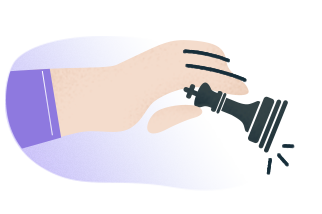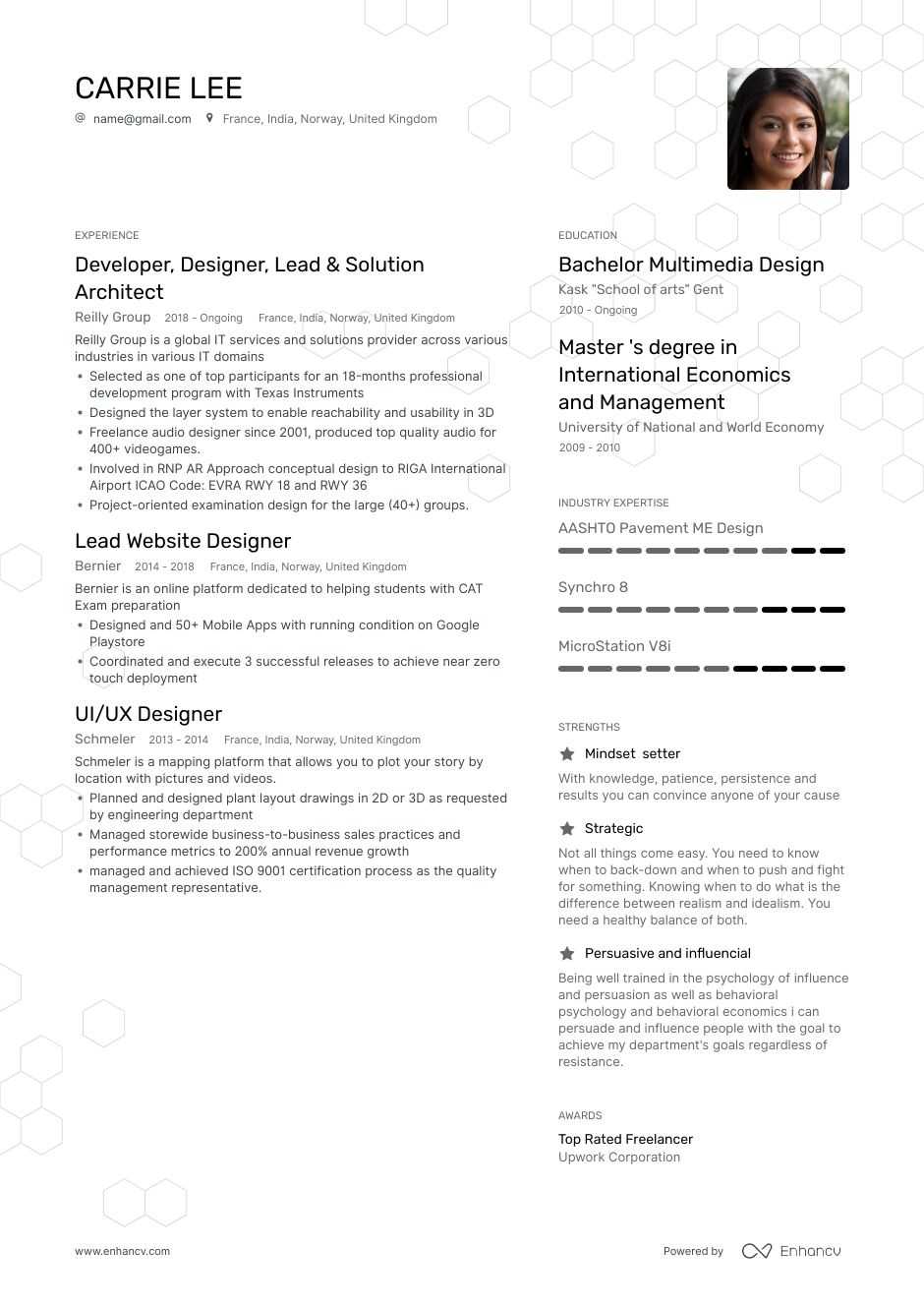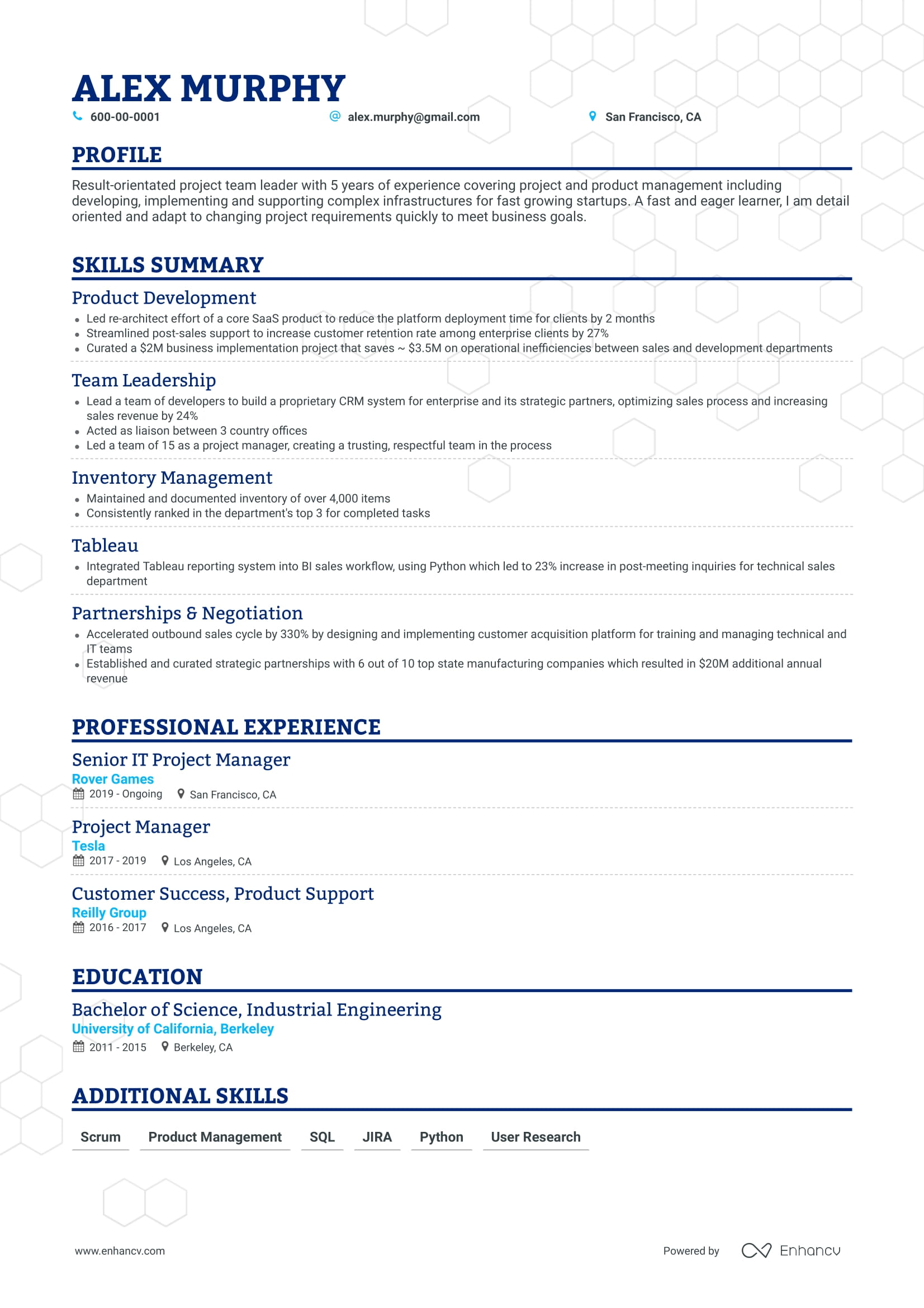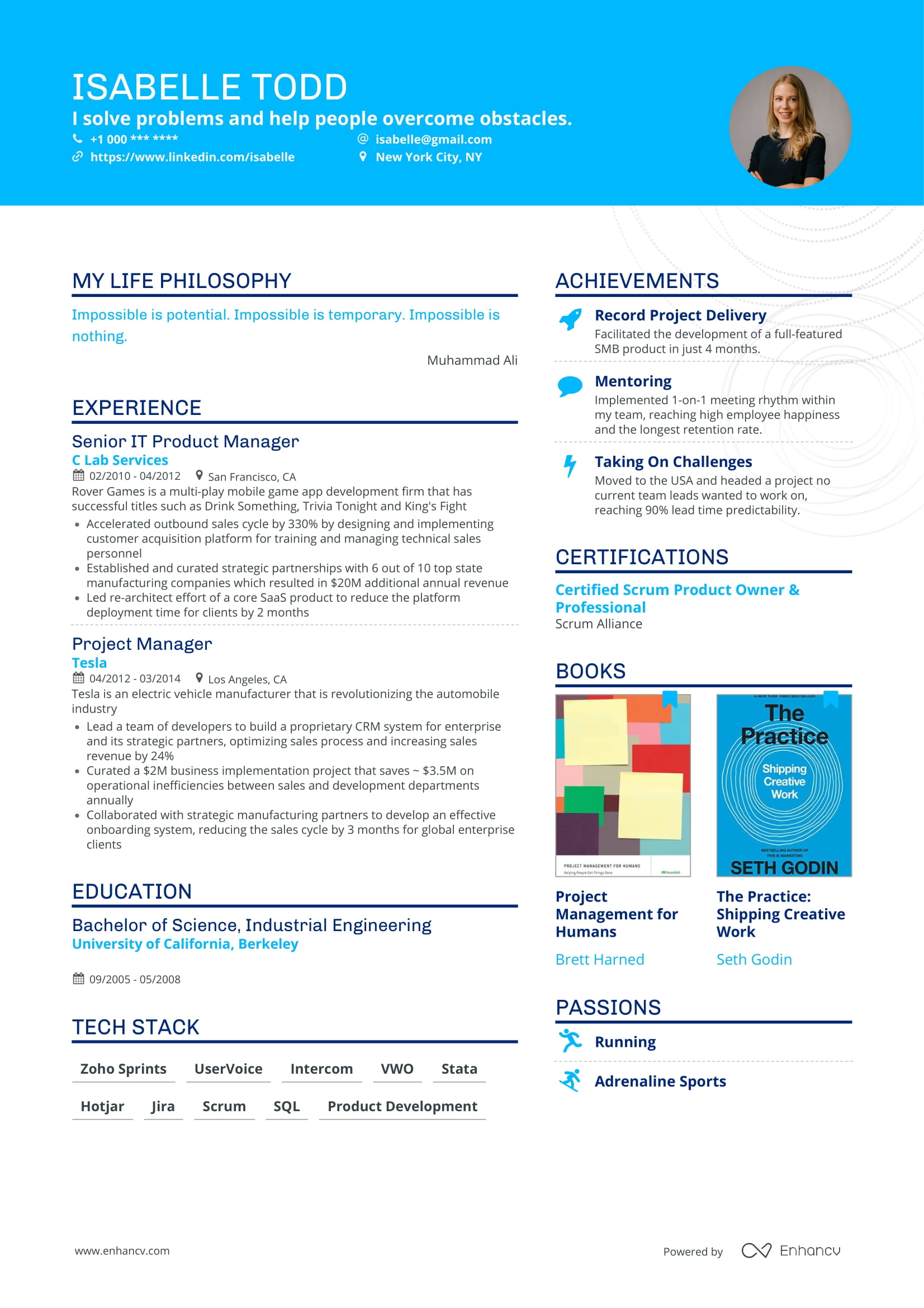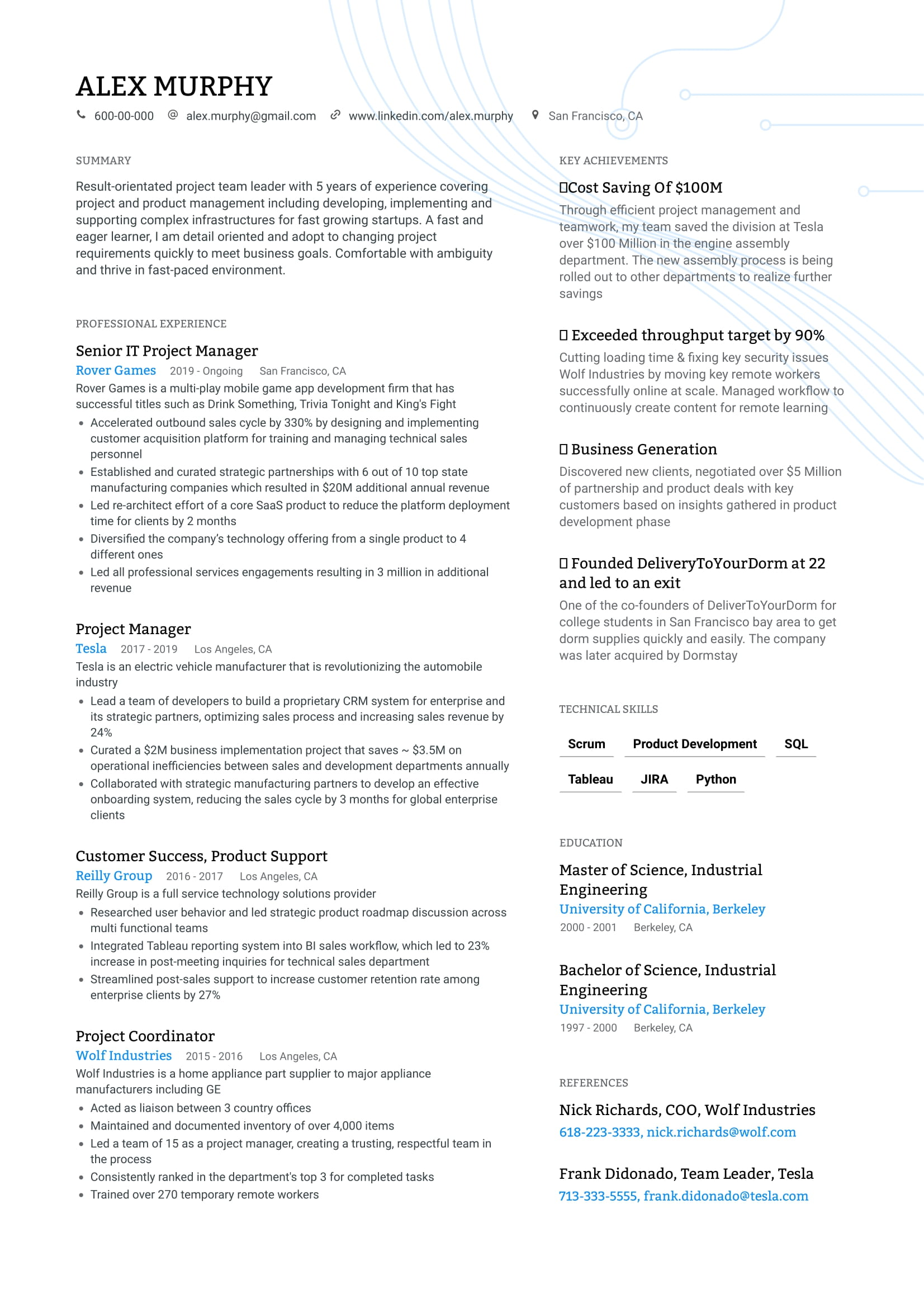Example Designer Resume - Browse more resume templates and build a stand-out resume
The job outlook for designers is always growing.
And it doesn’t matter if business people realize it or not, there's a place for designers in any field.
Whether it’s making a new product, launching a new service, or starting a new advertising campaign — there's design work associated with it.
And of all the other roles in the business world today, design makes the most impact. At least when it comes to first impressions and creating interest.
A design concept can make or break in a potential customer’s decision. And that happens within a few seconds of them interacting with it.
Designers have a deep understanding of human perception and how human beings interact with their outside world.
They know how to grab customers’ attention and keep them interested in ideas.
And that’s what keeps creative directors and lead designers always on the look for talented designers to hire in their agencies.
If you’re serious about landing the job you want, your resume must show that you can:
- Create high quality deliverables including logos, flyers, business cards, brochures, magazine, etc
- Come up with creative design concepts and layouts to meet the clients’ needs
- Communicate with clients, printers, and outside agencies to ensure a smooth design process
- Deliver your work on time to ease the process for your colleagues and guarantee client satisfaction
This Designer Resume Will Teach You
- 5 important sections every designer resume must have
- How to write a resume summary that stands out
- The right way to featuring your design experience in your resume
- How to highlight your design certifications and accomplishments
- 19 essential soft and technical skills to include in your skills section
Designer Resume Samples
Looking for Related Resumes?
- Graphic Designer Resume
- UI Designer Resume
- Web Designer Resume
- UX Designer Resume
- Motion Graphics Resume
How to Write a Designer Resume
Crafting a designer’s resume is like doing design.
You start with an idea in mind that you want to communicate through your work.
Then, you turn that idea into a message that the viewer can understand visually.
The way you communicate that message effectively is by creating a unique concept that grabs attention and leaves a strong impression.
And through all that, you apply the necessary design principles to ensure that your outcome will deliver results.
Those are the same steps you follow when creating your designer resume.
The idea you start with is that you’re the perfect candidate.
You deserve the job.
You have to show that in your message, and you’ll do it by creating your resume.
But what principles should you follow when creating your resume? And how do you know you’re making it the right way to land you the job you want?
Here’s what a recruiter will look for in your resume:
- Can you plan and illustrate new design concepts while following client requirements?
- Do you have a comprehensive understanding of business, branding, and marketing?
- Do you have the creative flair to create new design elements and layouts by hand or by using different design software?
- Are you experienced in working with outside parties such as agencies and printers?
The most important sections of a designer resume:
- Resume header to nudge the recruiter into checking your portfolio
- Designer summary to stand out from the competition
- Resume experience to sell your worth and your relevant work history
- Key skills to reinforce your designer work experience
- Certifications and accomplishments to strengthen your resume
The Right Way to Write a Designer Resume Header
It’s true.
Your resume header may not the best way to sell yourself.
And it won't have a huge impact on the hiring decision.
But it’s important in a different way.
It’s essential to leading the recruiter’s expectations and setting the tone for what comes next.
For example, the name of the product isn’t the most important information to show to the customer.
But, it’s essential to show it first so that viewers know what they’re looking at.
Your resume header is the first thing the recruiter looks at before they read the other sections.
That’s why you must write the best header you can.
Because it will maximize your chances of leaving a lasting positive impression.
Let’s look at an example:
This header is good.
It only shows important information about you and how you can be contacted.
Yet, it lacks a vital element that every designer resume must-have. — which is a link to your portfolio.
A designer’s resume can have the most persuasive sections, — but still not be convincing enough to the recruiter.
The best designers are spotted through their portfolios and their past biggest clients.
Now that your header has a link to your portfolio, you know you’re not missing on any chance of getting hired.
Once the recruiter sees your work, they’re more than happy to know more about your background.
They’ll have a much better feeling about hiring you and may end up doing so.
How to Write a Designer Summary That Works
If you’re fond of minimalistic design, this section is for you.
It’s called a summary for a reason.
But strangely enough, most designers struggle with writing their summary section.
They think they don’t have much to talk about.
They get lost in the details of what they should say in their summary.
The summary has to be only a few sentences short.
And at the same time, it should communicate your message as clearly as possible.
However, there are many things you can talk about as a graphic designer.
And it’s not clear which part is going to help you the most with landing the job you want.
When hiring managers read your resume, they’ll often be looking for:
- Years of experience
- Best companies you worked for
- Types of projects and elements you were responsible for creating
- Successful design projects you completed
- Results your work has achieved
A winning resume summary is like a story that enhances the recruiter’s interest.
It tells them where you come from, why you’re the right candidate, and where you’re heading in your career.
But most importantly, it doesn’t waste their time by stating irrelevant or unimportant information.
3 Designer Resume Samples - Summary
If you want to get hired in today’s competitive job market, your resume summary can’t look like this:
This tells very little about your design work and who you are.
And it’s possible that this same summary can be used by a dozen other designers applying for the same job.
This doesn’t make you look unique.
You need a summary that will stick inside the recruiter’s head that also shows your worth and experience.
To do that, you need to speak about:
- The technical skills and design tools are you experienced with
- What results did your design work achieve for your former employers
- Some design projects and deliverables were you responsible for in the past
- What you’re looking forward to after you get hired in the new company
This is much better than the previous summary.
But it’s still weak and can be improved with just a few more tweaks.
It lacks details and specificity to the designer position you’re applying to. And it doesn’t highlight the effect of your design work.
Now look at this:
The hiring manager reading this will have everything he needs to know about you.
It highlights how your creative spirit helped your former employer grow.
Also, it shows your relevant skills and experience in graphic design and business.
But most importantly, it provides details about the deliverables you were responsible for.
How to Feature Your Design Experience In Your Resume
Design is a wide field with lots of different requirements and outcomes. And it all depends on the position and the industry.
Two designers can have entirely different skills, work on completely different projects, and produce different deliverables all the time.
So, recruiters often have a specific profile in mind for the designer they want to hire.
They already know what they want.
That’s why it’s crucial to show in your experience section that you’re the best designer they can hire.
But how can you do that exactly?
Get this:
2 Designer Resume Experience Samples
This experience section lacks some key aspects that every winning designer resume needs.
First, It’s generic for any other designer role in the market.
Any designer can handle the responsibilities listed there.
Also, it doesn’t highlight the overlap between your past responsibilities and achievements.
There’s no clear connection between your presence at the previous company and how you helped it grow.
Finally, your responsibilities and experience aren’t aligned with what the hiring company wants.
So, how can you improve it?
You need to include the key responsibilities you handled and back that up with precise numbers for the results you achieved.
Recruiters want to know how your design work affected your former employer’s business positively.
They need to be certain that you can do what the new designer position requires you to do.
They want answers for:
- What was the nature of the creative concepts you create?
- What type of projects did you handle as a graphic designer in your previous job?
- Do you have experience working in teams and communicating with clients directly?
- Will your experience allow you to do your job at the new company better than any other candidate?
Notice how this is much better?
It’s no longer generic.
It sites your key responsibilities and how your work helped your former employer. And it shows numbers and tangible results to support that.
That’s the best way to communicate why you’re the best candidate for this job.
How to Describe the Duties of a Designer in a Resume
- Met with clients to understand their design preferences, requirements, and specifications
- Illustrated new concepts and layouts for brand identity, company logos, and product illustrations
- Selected typography, colors, and style based on the client’s company and needs
- Produced rough drafts for clients and revised them based on the feedback
- Advised clients about design styles and formats that fit their company needs
- Reviewed final layouts and provided feedback to other designers when necessary
- Communicated with printers and outside agencies to ensure high-quality printing and on-time delivery
Do You Need an Education Section as a Designer?
When it comes to creative domains like design, education can’t be the most important section.
Hiring managers won't rely on it to make their final hiring decision.
Instead, they’re more into seeing your work and learning more about your experience.
A master’s degree in graphic design won’t get you hired if your work is of low quality.
Yet, when there are hundreds of resumes stacking up in the recruiter’s inbox, education may come in handy.
Sure, you may have an amazing portfolio with many top-notch completed projects for your past employer.
But so might another dozen candidates applying for the same position.
If you want to be the one to get the job, put in your resume everything that will help you sell your expertise further.
19 Skills to Include in Your Designer Resume
Clients always ask for different projects with different requirements.
But at the same time, they want the outcome to be unique to their brand.
That's why the more relevant design skills you have, the better you are at your job.
Being a designer requires you to master a variety of design software — as well as an ability to sketch concepts and layouts by hand.
Also, you’ll likely be working with other designers, outside agencies, printers, and clients all the time.
That’s why your resume needs to show that your teamwork and communication skills are on point.
10 technical skills to include on a designer resume
- Photoshop
- Adobe Illustrator
- InDesign
- Typography
- Freehand
- Sketching
- Print Design
- Web Design (HTML/CSS)
- Premiere Pro
- After Effects
9 soft skills to include on a designer resume
- Communication
- Time management
- Teamwork
- Creativity
- Attention to details
- Presentation
- Desire to learn
- Meeting deadlines
- Multitasking
What Certifications Should you Include in Your Designer Resume?
Recruiters like to see proof of competence before their eyes when hiring designers.
That’s something you’ll present in other sections, especially by getting them to look at your portfolio.
However, there’s always more you can do to prove that you’re the best.
Certificates often serve as an easy yet effective way to highlight your competence.
It’s the best social proof for your experience in design.
3 designer certifications to show in your resume
- Adobe Certified Expert (ACE)
- Adobe Certified Associate (ACA)
- HTML5, CSS, Responsive Design Certificate, FreeCodeCamp
What are the tricks for the best designer resume?
- Design is a very large field that requires lots of different skills, experiences, and expectations. Make sure you tailor your designer resume to match the job description from the beginning
- Your portfolio is your greatest asset as a designer. Promote it repeatedly throughout different sections of your design resume
- The summary section is a great place to apply the famous “less is more” design principle. Keep it short and on point to what the recruiter is expecting to know about you.
- When done correctly, education and certifications can increase your chances of getting hired
